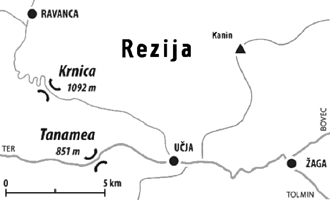
|
The Society of Folk Dance Historians (SFDH)
Music and Dance of Resija
[
Home |
About |
Encyclopedia | CLICK AN IMAGE TO ENLARGE |

|
 The conservation of the Resijan folk traditions has been favored by the high mountain ranges which encircle the Resija Valley. In this valley one of the most archaic Slovenian dialects is spoken, a dialect which has even developed some original innovations; here the folk tradition has preserved archaisms rarely found elsewhere in Europe.
The conservation of the Resijan folk traditions has been favored by the high mountain ranges which encircle the Resija Valley. In this valley one of the most archaic Slovenian dialects is spoken, a dialect which has even developed some original innovations; here the folk tradition has preserved archaisms rarely found elsewhere in Europe.
The folk tales that the Resijans rich imagination continuously adapts to the present day circumstances are rooted in the oldest European myths; in the Resijan music – in songs and dances – the old non-tempered scale is preserved and people sing and play only a single melody accompanied by a medieval bourdon (the drone pipe of a bagpipe). The valley's most typical folk instrument is still the violin, discarded elsewhere in favor of more modern instruments, and with it the Resijans imitate the sound of bagpipes, surely still in use here 200 or 300 years ago. Resijans still dance the medieval Contredanse (a French form of country dance) and continuously enrich it through their inexhaustible imagination.
The Val Resija Folk Group has performed the music and dances of these living Middle Ages all over Europe. The first report of a performance by Resijan dancers and players outside the home boundaries dates back to the year 1838, when they took part in the festivities celebrating Emperor Ferninand's visit to the city of Udine, Italy.
On the feast of the Assumption of the Virgin Mary (Šmána Miš) and at Carnival (Púst) the squares and inns of all the valley villages overflow with song and dance. And it is the folk music which is again the Resijan identification mark and community bond on other festive occasions like weddings (ženitke) and Resijan emigrants' gatherings.
Resijan players play the "cýtira," a violin which has been tuned to a higher pitch through the lowering of its bridge. The sound is thus sharper and more easily heard by the dancers in the square. The players sit and beat the rhythm by stamping their feet. They cannot read music and hundreds of tunes are handed down from father to son. The three young "cýtira" players in the Resijan Folk Group are all sons of older well-known local musicians. The "cýtire" are accompanied by a "búunkula" (also "brúunkala," "valika cýira," "bas") – an adapted cello or small three-stringed contrabass. The musician plays the bourdon on the open strings only using a contrabass bow. The "búnkula" player may be a man, a woman, or even a child, which is not the case for the "cýtira" player.
Dance music is based on a rhythmic unit of 3/8 and may have shorter (Ta Calćéucaua), longer (Ta Midvédaua), symmetrical (Čérni Potök), or assymetrical (Dö Po Štiglah) periods. The melodic extent can be confined to a fifth (Ta Ošöjska) and normaly does not exceed an octave. The player first performs the motive on the highest or on the two higest strings (na ténko, in a "thin" tone). When the theme comes to an end, he repeats it on the subdominate (na túslsto, in a "fat" tone) following an extremely simple modulation. The theme is repeated a number of times in the two tonalities, then the piece ends with a coda (the concluding passage of a piece or movement) played in a "thin" tone and bowing on an open string or with a glissando (a continuous slide upward or downward between two notes) on the higher string. With this sound the Resijan players imitate the final emptying of a bagpipe.
Some tunes are certainly very old, thus Čérni Potök with its archaic 15/8 rhythm. Others are more recent: Poti me dö Lipje and Lipa ma Marýca were composed in the years between the two world wars, while Ta Lipaušlka was compose by Vasák for the 1977 Carnival. The titles of the tunes denote the village where they originated (Ta Ošöljska from Osojani, Ta Sóbaška from Solbica, Ta Lipauška from Lipovac) or small places (Zagáta, Lipje, Bánt, Ăallci), streams (Čérni Potõk), and names of old time "cýtira" players (Calabás). Sometimes the titles remind us of ancient rituals (Dõ po Štiglah ("going down the stairs"), a wedding tune. The players used to wait for the bride to come out of her room on the first floor and go down the outside staircase on her way to the wedding, Ta Pústaua is a Carnival dance, or of either real or mythical persons' names (Lipa ma Marýca, Anarý nu Anarój), or of animals (Ta Midvédaua – "the bear dance"). Few tunes are merely instrumental (Dö po Štiglah), the most being linked to a written text.
DOCUMENTS
- Italy, a country.
- Rezijanka I and II, dances.
- Slovenia, a country
Selection from the Idyllwild Folk Dance Workshop 1985 syllabus.
This page © 2018 by Ron Houston.
Please do not copy any part of this page without including this copyright notice.
Please do not copy small portions out of context.
Please do not copy large portions without permission from Ron Houston.